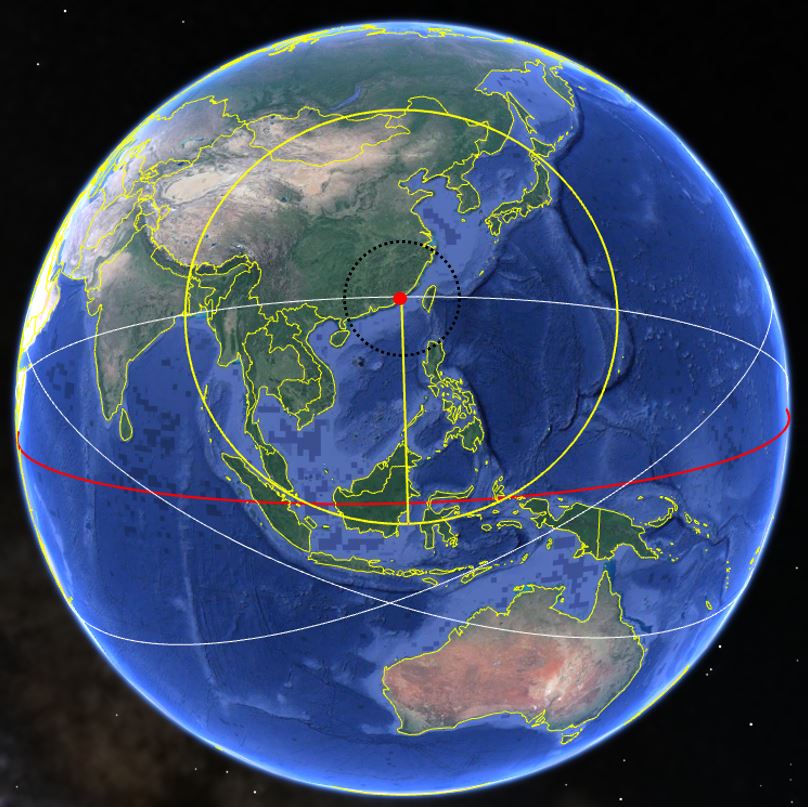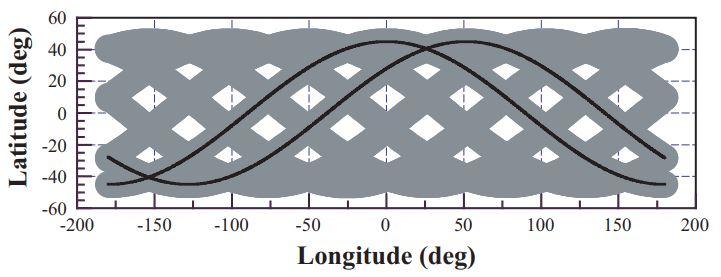UPDATE: In September 2018, UCS released an animated feature and video that explains how space-based missile defense works. Check it out here.
—
Articles citing a classified 2011 report by the Institute for Defense Analysis (IDA) have mistakenly suggested the report finds that a constellation of only 24 satellites can be used for space-based boost-phase missile defense.
This finding would be in contrast to many other studies that have shown that a space-based boost-phase missile defense system would require hundreds of interceptors in orbit to provide thin coverage of a small country like North Korea, and a thousand or more to provide thin coverage over larger regions of the Earth.
A 2011 letter from Missile Defense Agency (MDA) Director Patrick O’Reilly providing answers to questions by then-Senator Jon Kyl clarifies that the 24-satelllite constellation discussed in the IDA study is not a boost-phase missile defense system, but is instead a midcourse system designed to engage anti-ship missiles:

The system discussed by IDA appears to be a response to concerns about anti-ship ballistic missiles that China is reported to be developing. It would have far too few satellites for boost-phase defense against missiles from even North Korea, and certainly from a more sophisticated adversary.
The MDA letter says the 24 satellites might carry four interceptors each. Adding interceptors to the satellites does not fix the coverage problem, however: If one of the four interceptors is out of range, all the interceptors are out of range, since they move through orbit together. As described below, the coverage of a space-based system depends on the number of satellites and how they are arranged in orbit, as well as the ability of the interceptors they carry to reach the threat in time.
While this configuration would place four interceptors over some parts of the Earth, it would leave very large gaps in the coverage between the satellites. An attacker could easily track the satellites to know when none were overhead, and then launch missiles through the gaps. As a result, a defense constellation with gaps would realistically provide no defense.
(The IDA report is “Space Base Interceptor (SBI) Element of Ballistic Missile Defense: Review of 2011 SBI Report,” Institute for Defense Analyses, Dr. James D. Thorne, February 29, 2016.)
Why boost phase?
The advantage of intercepting during a ballistic missile’s boost phase—the first three to five minutes of flight when its engines are burning—is destroying the missile before it releases decoys and other countermeasures that greatly complicate intercepting during the subsequent midcourse phase, when the missile’s warhead is coasting through the vacuum of space. Because boost phase is short, interceptors must be close enough to the launch site of target missiles to be able to reach them during that time. This is the motivation for putting interceptors in low Earth orbits—with altitudes of a few hundred kilometers—that periodically pass over the missile’s launch site.
The fact that the interceptors must reach a boosting missile with a few minutes limits how far the interceptor can be from the launching missile and still be effective. This short time therefore limits the size of the region a given interceptor can cover to several hundred kilometers.
An interceptor satellite in low Earth orbit cannot sit over one point on the Earth, but instead circles the Earth on its orbit. This means an interceptor that is within range of a missile launch site at one moment will quickly move out of range. As a result, having even one interceptor in the right place at the right time requires a large constellation of satellites so that as one interceptor moves out of range another one moves into range.
Multiple technical studies have shown that a space-based boost phase defense would require hundreds or thousands of orbiting satellites carrying interceptors, even to defend against a few missiles. A 2012 study by the National Academies of Science and Engineering found that space-based boost phase missile defense would cost 10 times as much as any ground-based alternative, with a price tag of $300 billion for an “austere” capability to counter a few North Korean missiles.
Designing the system instead to attack during the longer midcourse phase significantly increases the time available for the interceptor to reach its target and therefore increases the distance the interceptor can be from a launch and still get there in time. This increases the size of the region an interceptor can cover—up to several thousand kilometers (see below). Doing so reduces the number of interceptors required in the constellation from hundreds to dozens.
However, intercepting in midcourse negates the rationale for putting interceptors in space in the first place, which is being close enough to the launch site to attempt boost phase intercepts. Defending ships against anti-ship missiles would be done much better and more cheaply from the surface.
Calculation of Constellation Size
Figure 1 shows how to visualize a system intended to defend against anti-ship missiles during their midcourse phases. Consider an interceptor designed for midcourse defense on an orbit (white curve) that carries it over China (the red curve is the equator). If the interceptor is fired out of its orbit shortly after detection of the launch of an anti-ship missile with a range of about 2,000 km, it would have about 13 minutes to intercept before the missile re-entered the atmosphere. In those 13 minutes, the interceptor could travel a distance of about 3,000 km, which is the radius of the yellow circle. (This assumes δV = 4 km/s for the interceptor, in line with the assumptions in the National Academies of Science and Engineering study.)
The yellow circle therefore shows the size of the area this space-based midcourse interceptor could in principle defend against such an anti-ship missile.

Fig. 1. The yellow circle shows the coverage area of a midcourse interceptor, as described in the post; it has a radius of 3,000 km. The dotted black circle shows the coverage area of a boost-phase interceptor; it has a radius of 800 km.
However, the interceptor satellite must be moving rapidly to stay in orbit. Orbital velocity is 7.6 km/s at an altitude of 500 km. In less than 15 minutes the interceptor and the region it can defend will have moved more than 6,000 km along its orbit (the white line), and will no longer be able protect against missiles in the yellow circle in Figure 1.
To ensure an interceptor is always in the right place to defend that region, there must be multiple satellites in the same orbit so that one satellite moves into position to defend the region when the one in front of it moves out of position. For the situation described above and shown in Figure 1, that requires seven or eight satellites in the orbit.
At the same time, the Earth is rotating under the orbits. After a few hours, China will no longer lie under this orbit, so to give constant interceptor coverage of this region, there must be interceptors in additional orbits that will pass over China after the Earth has rotated. Each of these orbits must also contain seven or eight interceptor satellites. For the case shown here, only two additional orbits are required (the other two white curves in Figure 1).
Eight satellites in each of these three orbits gives a total of 24 satellites in the constellation to maintain coverage of one or perhaps two satellites in view of the sea east of China at all times. This constellation and could therefore only defend against a small number of anti-ship missiles fired essentially simultaneously. Defending against more missiles would require a larger constellation.
If the interceptors are instead designed for boost-phase rather than midcourse defense, the area each interceptor could defend is much smaller. An interceptor with the same speed as the one described above could only reach out about 800 km during the boost time of a long-range missile; this is shown by the dashed black circle in Figure 1.
In this case, the interceptor covering a particular launch site will move out range of that site very quickly—in about three and a half minutes. Maintaining one or two satellites over a launch site at these latitudes will therefore require 40 to 50 satellites in each of seven or eight orbits, for a total of 300 to 400 satellites.
The system described—40 to 50 satellites in each of seven or eight orbits—would only provide continuous coverage against launches in a narrow band of latitude, for example, over North Korea if the inclination of the orbits was 45 degrees (Fig. 2). For parts of the Earth between about 30 degrees north and south latitude there would be significant holes in the coverage. For areas above about 55 degrees north latitude, there would be no coverage. Broader coverage to include continuous coverage at other latitudes would require two to three times that many satellites—1,000 or more.
As discussed above, defending against more than one or two nearly simultaneous launches would require a much larger constellation.

Fig. 2. The figure shows the ground coverage (gray areas) of interceptor satellites in seven equally spaced orbital planes with inclination of 45°, assuming the satellites can reach laterally 800 km as they de-orbit. The two dark lines are the ground tracks of two of the satellites in neighboring planes. This constellation can provide complete ground coverage for areas between about 30° and 50° latitude (both north and south), less coverage below 30°, and no coverage above about 55°.
For additional comments on the IDA study, see Part 2 of this post.
